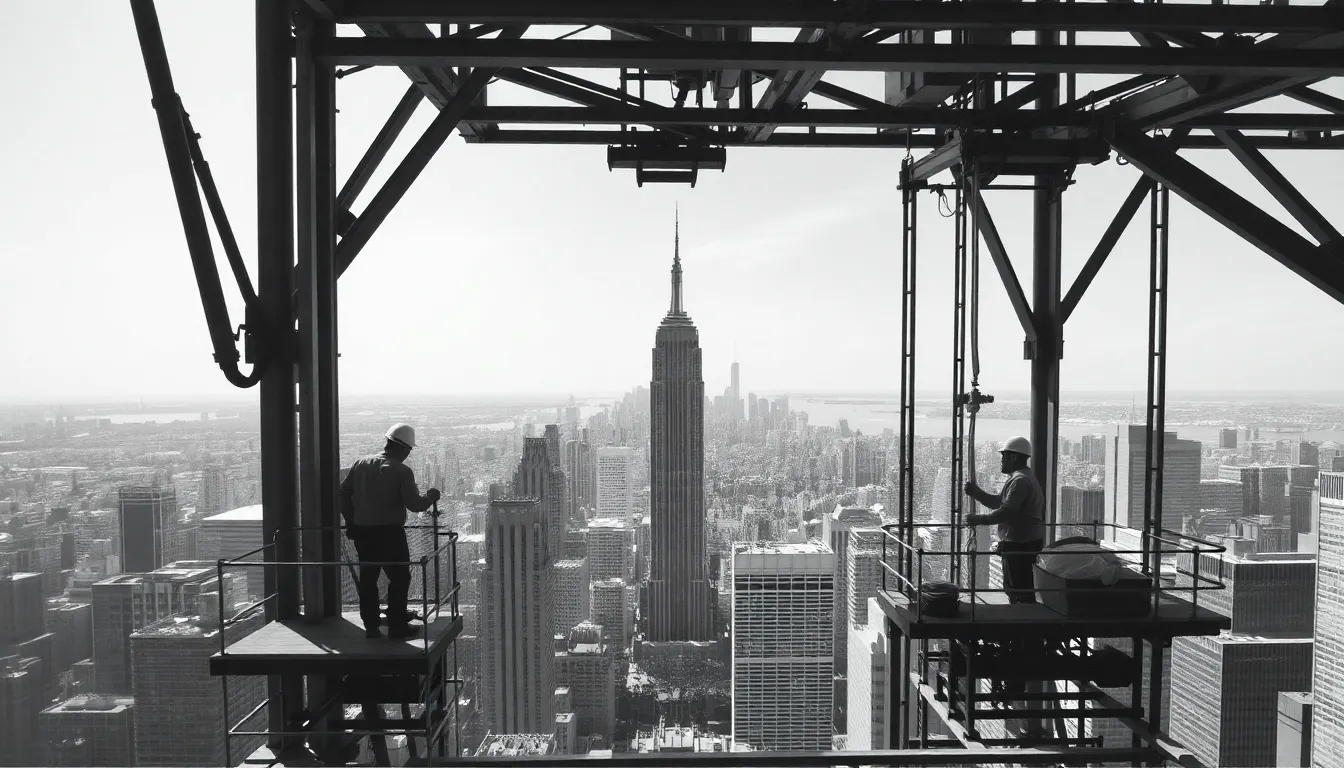In the bustling heart of New York City, a towering giant was born from steel and ambition—the Empire State Building. As construction crews raced against time, this architectural marvel transformed the skyline and captured the imagination of millions. Picture workers dangling from beams, defying gravity and common sense, all in the name of progress. It’s a scene that would make even the bravest of daredevils think twice!
But beneath the hard hats and the clanging of steel, there’s a tale of grit, determination, and a sprinkle of chaos. The Empire State Building wasn’t just a project; it was a symbol of hope during the Great Depression. As it reached for the clouds, it brought dreams to life and united a city. Dive into the fascinating story of how this iconic landmark came to be, and discover the quirks and triumphs that shaped its legendary status.
Table of Contents
ToggleHistorical Context of the Empire State Building
Constructed during the Great Depression, the Empire State Building served as a beacon of hope for many New Yorkers. Completed in 1931, this iconic skyscraper emerged from a period of economic hardship and uncertainty. During its construction, nearly 3,400 workers labored on-site, showcasing remarkable dedication and courage amid tough conditions.
Designed by architect William F. Lamb, the Empire State Building epitomized the Art Deco architectural style. Standing at 1,454 feet, it reigned as the tallest building in the world for 40 years until the World Trade Center’s completion. With 102 stories, it featured a diverse array of office spaces, which attracted numerous businesses, stimulating economic growth in Manhattan.
The construction project galvanized the city and demonstrated American ingenuity. Surpassing rivals, the workers utilized innovative techniques and materials, dramatically changing the skyline of New York City. The completed structure not only contributed to the city’s economy but also symbolized resilience and strength.
As a landmark, the Empire State Building drew millions of tourists annually, further solidifying its status. Each year, visitors flocked to the observation deck for panoramic views, reinforcing the building’s cultural significance. Recognized as a National Historic Landmark, it continues to inspire admiration and serves as a testament to the architectural vision of the early 20th century.
Historical context deeply enriches the understanding of the Empire State Building. This skyscraper reflects not only a monumental achievement in construction but also an enduring symbol of hope and unity. Historical narratives around its completion resonate with the spirit of perseverance, capturing a pivotal time in New York City’s evolution.
Construction Timeline

The construction of the Empire State Building spanned from 1930 to 1931, showcasing an impressive pace that matched the ambition of its design.
Key Milestones
Groundbreaking occurred on March 17, 1930, marking the official start of the project. The steel framework quickly rose, reaching the 50th floor by June 1930. July 1930 saw the completion of the building’s highest point, often described as a significant achievement in construction. In November 1931, the Empire State Building officially opened its doors, heralding its status as one of the tallest skyscrapers in the world.
Major Events
Workers experienced challenging conditions throughout the project. Daily, they faced tough weather, yet safety measures were implemented to protect them. Scaffolding systems allowed workers to carry out tasks efficiently despite the height. During a ceremony on April 19, 1931, a radio broadcast celebrated the building’s nearing completion, capturing the excitement of the city. On February 21, 1931, President Herbert Hoover turned on the building’s lights, symbolizing hope for the nation amid the Great Depression.
Architectural Design
The Empire State Building showcases a remarkable architectural design that captures attention.
Influences and Style
Art Deco influences are prominently displayed throughout the structure. Bold geometric shapes and intricate detailing characterize its design. Features like the distinctive spire and ornamental crown add to its classic appeal. When designing the building, architect William F. Lamb drew inspiration from modern skyscraper trends and American culture. Notably, the façade consists of Indiana limestone and granite, enhancing its elegance while promoting durability. The design reflects a combination of functionality and stunning aesthetics, setting the Empire State Building apart from other structures of the time.
Notable Architects
William F. Lamb is the primary architect associated with the Empire State Building. His innovative vision transformed a challenging site into an iconic landmark. Known for his expertise in high-rise design, Lamb utilized modern construction techniques to streamline the project. Consulting architect Ralph Walker contributed ideas that enhanced the building’s overall functionality. Both architects combined their skills to ensure the structure met the demanding needs of commercial tenants. Their collaboration produced a masterpiece that remains influential in the field of architecture today.
Engineering Innovations
Innovative engineering techniques set the Empire State Building’s construction apart. This iconic structure employed methods that streamlined the building process, enabling rapid progress.
Construction Techniques
Prefabricated steel components played a crucial role, allowing for swift assembly on-site. Engineers utilized crane systems designed to lift heavy materials efficiently. This strategy facilitated the rapid rise of the building’s steel framework, achieving remarkable heights in short timeframes. Workers erected multiple floors simultaneously, increasing productivity and expediting completion. The use of high-strength steel ensured the tower’s stability while minimizing weight, making it an engineering marvel of its era.
Safety Measures Implemented
Safety measures prioritized worker protection on the construction site. Workers frequently utilized safety harnesses to prevent falls from great heights. Scaffolding systems were carefully designed to support various constructions while enhancing worker mobility. Regular safety drills reinforced protocols, cultivating a secure environment amid challenging conditions. The installation of a rescue elevator further guaranteed quick access for emergency services. These strategies exemplified a commitment to safety, contributing to the project’s overall success.
The Impact on New York City
The Empire State Building significantly shaped New York City’s landscape and economy. Its construction during the Great Depression brought hope and revitalization to a struggling city.
Economic Benefits
This skyscraper provided a substantial boost to the local economy by creating nearly 3,400 jobs. Office spaces attracted numerous businesses, stimulating further employment and growth. Increased tourism generated additional revenue for local shops and restaurants, as millions of visitors flocked to see the iconic structure. Revenues from taxes on the bustling businesses surrounding the building contributed to city finances. Construction innovations also set industry standards that improved efficiencies in future projects.
Cultural Significance
Culturally, the Empire State Building became a symbol of resilience for the American people. Its Art Deco design inspired countless imitators, reshaping architectural trends across the nation. Iconic moments, such as its featuring in movies and television, cemented its status as a recognized global landmark. Celebrations and events often center around the building, further embedding it into the fabric of city life. This structure stands not only as an architectural marvel but also as a bastion of hope and ambition, reflecting the spirit of New Yorkers navigating adversity.
The Empire State Building stands as a testament to human determination and creativity. Its construction not only reshaped New York City’s skyline but also provided hope during a challenging era. This iconic skyscraper embodies the spirit of resilience and ambition that defines the city and its people.
As a symbol of progress and innovation, the building continues to inspire generations. Its architectural beauty and historical significance ensure that it remains a beloved landmark. The Empire State Building is more than just a structure; it’s a reminder of what can be achieved through hard work and unity, capturing the essence of New York City’s enduring legacy.


